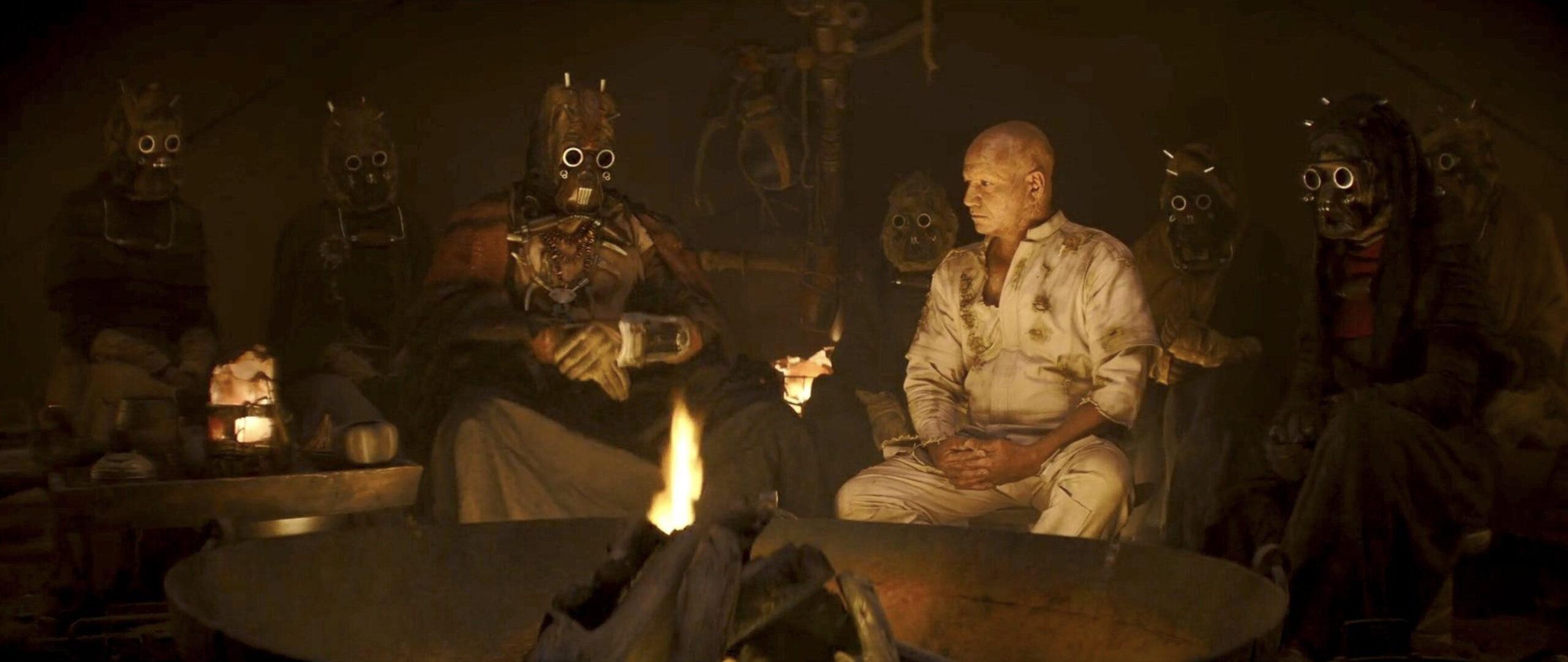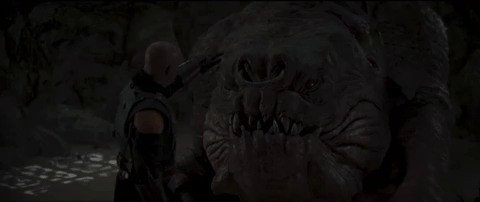
Star Wars may take place in a galaxy far, far away—with all the limitless possibilities such a premise entails—but it is particularly attached to Tatooine, the desert planet once home to Luke and Anakin Skywalker. The draw is obvious: Tatooine was the first Star Wars planet ever depicted in A New Hope, and Luke staring into the binary sunset and yearning for adventure somewhere in the cosmos remains a timeless image. It is the birthplace of the franchise’s most important characters, and thus, the unassuming center of this galactic franchise.
The Disney+ series The Book of Boba Fett is the latest Star Wars project to put down roots in Tatooine, following the infamous bounty hunter from his miraculous escape from the sarlacc pit to a takeover of territory once controlled by Jabba the Hutt. And it won’t even be the last show this year to be set on the planet, as Disney also plans to release its Obi-Wan Kenobi series with Ewan McGregor and Hayden Christensen reprising their roles from the prequel trilogy. What was Obi-Wan up to after Revenge of the Sith? Living the hermit life on Tatooine.
Tatooine is a spiritual home base for Star Wars; it’s a grounding presence in a franchise that includes a ’50s-style diner in the middle of a futuristic metropolis and a planet housed by insectoids capable of manufacturing weapons of mass destruction. However, as the franchise keeps finding excuses to return to Tatooine, the planet has started losing its rugged charm. Perhaps Anakin was right about sand all those years ago. Going forward, Star Wars ought to let the past die and meaningfully explore the rest of the galaxy. Until then, though, at least the good news is that even as Tatooine has overstayed its welcome, The Book of Boba Fett has more on its mind than nostalgia for nostalgia’s sake: It wants to repair the image of the planet’s most misunderstood inhabitants.
After escaping the sarlacc pit in the series premiere, a severely injured Boba is captured by a group of Tusken Raiders, who leave him tied up in their camp alongside another prisoner. Given the troublesome history of characters being imprisoned by the Tuskens (see: Shmi Skywalker in Attack of the Clones), Boba’s situation had hardly improved. But when he successfully kills a sand monster—one that Ringer colleague Ben Lindbergh accurately described as Goro from Mortal Kombat—Boba earns the respect of the Tuskens. It’s clear that the Tuskens abide by a kind of warrior’s code. (As we previously saw from The Mandalorian’s fifth episode, “The Gunslinger,” it’s even possible to barter for safe passage across their territory.) It’s telling that bounty hunters like Mando and Boba can form a kinship with the Tuskens: Despite very different backgrounds, they adhere to a similar philosophy. And by proving himself in combat, Boba endears himself to the tribe.
The second episode further fleshes out Boba’s relationship to the Tusken tribe, with the bounty hunter going so far as to teach them how to ride speeders. The Tuskens, in turn, instruct him on how to wield a gaderffii stick, their old-school weapon of choice that Boba still uses in the present timeline. Ultimately, Boba and the Tuskens pull off a Western-inspired train robbery, one that solidifies the strength and resourcefulness of an indigenous group whose history on Tatooine—and prickly relationship with outsiders trespassing on what they perceive to be their land—feels of a piece with the Fremen in Dune. (In this analogy, Boba is Paul Atreides, which is fitting seeing as he also trips balls in the desert thanks to some type of Peyote Lizard™.)
This is a far cry from how the Tuskens have been portrayed in the films. They have been reduced to mindlessly violent insurgents—labeled by Anakin as “animals” when he slaughtered an entire tribe as retaliation for killing his mother. But as The Mandalorian teased and The Book of Boba Fett builds upon, the Tuskens are just trying to survive and hold on to ancient traditions in an increasingly modern world. (There are a lot of real-world parallels between the Tuskens and actual indigenous populations, something that resonated with actor Temuera Morrison in relation to his Māori ancestry.) The Star Wars universe may be unforgiving and inhospitable, but there aren’t as many monsters as there are groups, like the Tuskens, who are simply misunderstood.

The Book of Boba Fett hasn’t handled the Tusken Raiders seamlessly—the abrupt massacre of Boba’s tribe in the third episode could be construed as a haphazard attempt at character development—but the series has gone a long way toward restoring their tainted image from the George Lucas–directed entries in the franchise. They’ve been granted interiority and development far deeper than when they were merely a foreign threat to Luke in A New Hope.
The Book of Boba Fett’s PR rehabilitation has extended beyond the Tuskens, to the extent that the show feels like it was sponsored by the Tatooine tourism board. After surviving an assassination attempt from a scary-looking Wookiee known as Black Krrsantan in the third episode, Boba is gifted a baby rancor by Jabba’s slimy cousins, which is, I suppose, a decent “We’re sorry for attempting to murder you by hiring a giant bear wearing brass knuckles” gift. (All the good PR in the galaxy won’t make the Hutts any less unpleasant.) While rancors aren’t native to Tatooine, the species’ on-screen legacy is intrinsically linked to Luke’s terrifying encounter with one at Jabba’s palace in Return of the Jedi.
Before The Book of Boba Fett, the impression of the rancor was, like the Tuskens, something monstrous and mindless in its savagery. Instead, it appears rancors are basically the pit bulls of the Star Wars universe: Being violent isn’t necessarily their nature, but a result of how they’re nurtured. “Rancor are emotionally complex creatures,” the creature’s handler (played, incredibly, by Danny Trejo) explains to Boba. “They’re powerful fighters, so that is what most know, but they form strong bonds with their owners.” The baby rancor imprints on Boba when he lays his eyes on him, and he can be a loving companion with the right care. In fact, Boba doesn’t just want to raise the rancor: He wants to one day ride it. It’s hard to get much of a read on Boba’s stoic personality, but it’s clear that he has a soft spot for animals. And in its own way, the baby rancor evokes a sense of awe that also makes the viewer audibly “aww” when Boba pets him like a giant prehistoric-looking puppy:

Once again, The Book of Boba Fett subverts the audience’s expectations by adding nuance to a creature previously reduced to a ravenous monster on the big screen. On the whole, this appears to be the guiding principle behind Jon Favreau and Dave Filoni’s small-screen extensions of the Star Wars universe—the “darker, freakier” side of the franchise doesn’t need to be painted as one-dimensional. Rather, it’s about celebrating the weirdest and most misunderstood corners of Star Wars in all its idiosyncrasies.
In a sign of the changing times, even Tatooine is trying to class itself up a bit. During The Book of Boba Fett’s fourth episode, Black Krrsantan unleashes his anger on a group of gambling Trandoshans at the Mos Espa cantina when its proprietor, Madam Garsa, tries to calm the Wookiee down. She insists on covering his tab if he doesn’t escalate the situation, despite seedy cantina bar fights practically being a rite of passage in Star Wars. “Thousands once cheered such a display, but those days have passed,” she tells him. Of course, old traditions die hard:

So, sure, cantinas on Tatooine are still hosts to incredibly violent squabbles, but it’s the thought (and peaceful gesture) that counts. So long as Trandoshans are getting their arms chopped off in public, Tatooine will hardly be mistaken for the picturesque Naboo. But that doesn’t mean the planet isn’t capable of evolving. After years of horrible PR, The Book of Boba Fett has shown that Tatooine is more than a wretched hive of scum and villainy.

